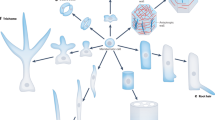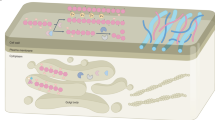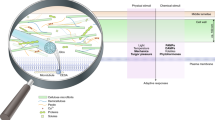Abstract
Plant cell walls are the starting materials for many commercial products, from lumber, paper and textiles to thickeners, films and explosives. The cell wall is secreted by each cell in the plant body, forming a thin fibreglass-like network with remarkable strength and flexibility. During growth, plant cells secrete a protein called expansin, which unlocks the network of wall polysaccharides, permitting turgor-driven cell enlargement. Germinating grass pollen also secretes an unusual expansin that loosens maternal cell walls to aid penetration of the stigma by the pollen tube. Expansin's action has puzzling implications for plant cell-wall structure. The recent explosion of gene sequences and expression data has given new hints of additional biological functions for expansins.
This is a preview of subscription content, access via your institution
Access options
Subscribe to this journal
Receive 51 print issues and online access
$199.00 per year
only $3.90 per issue
Buy this article
- Purchase on Springer Link
- Instant access to full article PDF
Prices may be subject to local taxes which are calculated during checkout




Similar content being viewed by others
References
Varner, J. E. & Lin, L.-S. Plant cell wall architecture. Cell 56, 231–239 ( 1989).
Talbott, L. D. & Ray, P. M. Molecular size and separability features of pea cell wall polysaccharides. Implications for models of primary wall structure. Plant Physiol. 92, 357– 368 (1992).
Roberts, K. The plant extracellular matrix, in a new expansive mood. Curr. Opin. Cell Biol. 6, 688–694 (1994).
McCann, M. C., Wells, B. & Roberts, K. Complexity in the spatial localization and length distribution of plant cell-wall matrix polysaccharides. J. Microsc. 166, 123–136 (1992).
McCann, M. C., Wells, B. & Roberts, K. Direct visualization of cross-links in the primary plant cell wall. J. Cell Sci. 96, 323– 334 (1990).
Carpita, N. C. & Gibeaut, D. M. Structural models of primary cell walls in flowering plants: consistency of molecular structure with the physical properties of the walls during growth. Plant J. 3, 1–30 (1993).
Cosgrove, D. J. Enzymes and other agents that enhance cell wall extensibility. Annu. Rev. Plant Physiol. Plant Mol. Biol. 50, 391– 417 (1999).
Cosgrove, D. J. Water uptake by growing cells: an assessment of the controlling roles of wall relaxation, solute uptake and hydraulic conductance. Int. J. Plant. Sci. 154, 10–21 ( 1993).
Rayle, D. L. & Cleland, R. E. The acid growth theory of auxin-induced cell elongation is alive and well. Plant Physiol. 99 , 1271–1274 (1992).
Cosgrove, D. J. Characterization of long-term extension of isolated cell walls from growing cucumber hypocotyls. Planta 177, 121– 130 (1989).
McQueen-Mason, S., Durachko, D. M. & Cosgrove, D. J. Two endogenous proteins that induce cell wall expansion in plants. Plant Cell 4, 1425– 1433 (1992).
Cosgrove, D. J. & Li, Z.-C. Role of expansin in developmental and light control of growth and wall extension in oat coleoptiles. Plant Physiol. 103, 1321– 1328 (1993).
Keller, E. & Cosgrove, D. J. Expansins in growing tomato leaves. Plant J. 8, 795– 802 (1995).
Cho, H. T. & Kende, H. Expansins and internodal growth of deepwater rice. Plant Physiol. 113, 1145 –1151 (1997).
Wu, Y., Sharp, R. E., Durachko, D. M. & Cosgrove, D. J. Growth maintenance of the maize primary root at low water potentials involves increases in cell-wall extension properties, expansin activity, and wall susceptibility to expansins. Plant Physiol. 111, 765– 772 (1996).
Cho, H. T. & Kende, H. Expression of expansin genes is correlated with growth in deepwater rice. Plant Cell 9, 1661–1671 (1997).
Vriezen, W. H., De Graaf, B., Mariani, C. & Vosenek, L. A. C. J. Submergence induces expansin gene expressin in flooding tolerant Rumex palustris and not in flooding intolerant R. acetosa. Planta 210, 956–963 ( 2000).
Hutchison, K. W., Singer, P. B., Diaz-Sala, C. & Greenwood, M. S. Expansins are conserved in conifers and expressed in response to exogenous auxin. Plant Physiol. 120, 827– 832 (1999).
Fleming, A. J., Caderas, D., Wehrli, E., McQueen-Mason, S. & Kuhlemeier, C. Analysis of expansin-induced morphogenesis on the apical meristem of tomato. Planta 208, 166– 174 (1999).
Moore, R. C., Flecker, D. & Cosgrove, D. J. Expansin action on cells with tip growth and diffuse growth. J. Cell. Biochem. (Suppl.) 21A, 457; abstract J5–312 (1995).
Link, B. M. & Cosgrove, D. J. Acid-growth response and α-expansins in suspension cultures of bright yellow 2 tobacco. Plant Physiol. 118, 907–916 ( 1998).
Fleming, A. J., McQueen-Mason, S., Mandel, T. & Kuhlemeier, C. Induction of leaf primordia by the cell wall protein expansin. Science 276, 1415–1418 ( 1997).
Green, P. B. Expansin and morphology: a role for biophysics. Trends Plant Sci. 2, 365–366 ( 1997).
McQueen-Mason, S. & Cosgrove, D. J. Expansin mode of action on cell walls: Analysis of wall hydrolysis, stress relaxation, and binding. Plant Physiol. 107, 87– 100 (1995).
Cosgrove, D. J. & Durachko, D. M. Autolysis and extension of isolated walls from growing cucumber hypocotyls. J. Exp. Bot. 45, 1711–1719 (1994).
Reinhardt, D., Wittwer, F., Mandel, T. & Kuhlemeier, C. Localized upregulation of a new expansin gene predicts the site of leaf formation in the tomato meristem. Plant Cell 10, 1427–1437 (1998).
Kende, H., Van der Knaap, E. & Cho, H. T. Deepwater rice: A model plant to study stem elongation. Plant Physiol. 118, 1105– 1110 (1998).
Catala, C., Rose, J. K. & Bennett, A. B. Auxin-regulated genes encoding cell wall-modifying proteins are expressed during early tomato fruit growth. Plant Physiol. 122, 527–534 ( 2000).
Brummell, D. A., Harpster, M. H. & Dunsmuir, P. Differential expression of expansin gene family members during growth and ripening of tomato fruit. Plant Mol. Biol. 39, 161–169 (1999).
Orford, S. J. & Timmis, J. N. Specific expression of an expansin gene during elongation of cotton fibres. Biochim. Biophys. Acta Gene Struct. Expression 1398, 342– 346 (1998).
Shimizu, Y. et al. Changes in levels of mRNAs for cell wall-related enzymes in growing cotton fiber cells. Plant Cell Physiol. 38, 375–378 (1997).
Cho, H. T. & Cosgrove, D. J. Altered expression of expansin modulates leaf growth and pedicel abscission in Arabidopsis thaliana. Proc. Natl Acad. Sci. USA (in the press).
Shcherban, T. Y. et al. Molecular cloning and sequence analysis of expansins—a highly conserved, multigene family of proteins that mediate cell wall extension in plants. Proc. Natl Acad. Sci. USA 92, 9245–9249 (1995).
Smith, P. M., Knox, R. B. & Singh, M. B. in Pollen Biotechnology: Gene Expression and Allergen Characterization (eds Mohapatra, S. S. & Knox, R. B.) 125– 143 (Chapman & Hall, New York, 1996).
Knox, B. & Suphioglu, C. Environmental and molecular biology of pollen allergens. Trends Plant Sci. 1, 156–164 (1996).
Cosgrove, D. J., Bedinger, P. & Durachko, D. M. Group I allergens of grass pollen as cell wall-loosening agents. Proc. Natl Acad. Sci. USA 94, 6559 –6564 (1997).
Heslop-Harrison, Y., Reger, B. J. & Heslop-Harrison, J. The pollen-stigma interaction in the grasses. 5. Tissue organization and cytochemistry of the stigma (“silk”) of Zea mays L. Acta Bot. Neerl. 33, 81– 99 (1984).
Carpita, N. C. Structure and biogenesis of the cell walls of grasses. Annu. Rev. Plant Physiol. Plant Mol. Biol. 47, 445– 476 (1996).
Crowell, D. N. Cytokinin regulation of a soybean pollen allergen gene. Plant Mol. Biol. 25, 829–835 ( 1994).
Downes, B. P. & Crowell, D. N. Cytokinin regulates the expression of a soybean β-expansin gene by a post-transcriptional mechanism. Plant Mol. Biol. 37, 437–444 (1998).
Rose, J. K. C. & Bennett, A. B. Cooperative disassembly of the cellulose-xyloglucan network of plant cell walls: parallels between cell expansion and fruit ripening. Trends Plant Sci. 4, 176–183 (1999).
Fischer, R. L. & Bennett, A. B. Role of cell wall hydrolases in fruit ripening. Annu. Rev. Plant Physiol. Plant Mol. Biol. 42, 675–703 ( 1991).
Giovannoni, J. J., DellaPenna, D., Bennett, A. B. & Fischer, R. L. Expression of a chimeric polygalacturonase gene in transgenic rin (ripening inhibitor) tomato fruit results in polyuronide degradation but not fruit softening. Plant Cell 1, 53–63 (1989).
Tieman, D. M., Harriman, R. W., Ramamohan, G. & Handa, A. K. An antisense pectin methylesterase gene alters pectin chemistry and soluble solids in tomato fruit. Plant Cell 4, 667 –679 (1992).
Brummell, D. A., Hall, B. D. & Bennett, A. B. Antisense suppression of tomato endo-1,4-β-glucanase Cel2 mRNA accumulation increases the force required to break fruit abscission zones but does not affect fruit softening. Plant Mol. Biol. 40, 615–622 (1999).
Rose, J. K. C., Lee, H. H. & Bennett, A. B. Expression of a divergent expansin gene is fruit-specific and ripening-regulated. Proc. Natl Acad. Sci. USA 94 , 5955–5960 (1997).
Brummell, D. A. et al. Modification of expansin protein abundance in tomato fruit alters softening and cell wall polymer metabolism during ripening. Plant Cell 11, 2203–2216 (1999).
Civello, P. M., Powell, A. L. T., Sabehat, A. & Bennett, A. B. An expansin gene expressed in ripening strawberry fruit. Plant Physiol. 121, 1273–1279 (1999).
Rose, J. K. C., Cosgrove, D. J., Albersheim, P., Darvill, A. G. & Bennett, A. B. Detection of expansin proteins and activity during tomato fruit ontogeny. Plant Physiol. (in the press).
Cosgrove, D. J. Relaxation in a high-stress environment: The molecular bases of extensible cell walls and cell enlargement. Plant Cell 9, 1031–1041 (1997).
Durachko, D. M. & Cosgrove, D. J. Expression patterns for selective expansin genes in Arabidopsis. Annu. Meeting Am. Soc. Plant Physiol. Abstr. 56 ( 1999).
Im, K. H., Cosgrove, D. J. & Jones, A. M. Subcellular localization of expansin mRNA in xylem cells. Plant Physiol. 123, 463– 470 (2000).
Fenwick, K. M., Apperley, D. C., Cosgrove, D. J. & Jarvis, M. C. Polymer mobility in cell walls of cucumber hypocotyls. Phytochem. 51, 17–22 ( 1999).
Grobe, K., Becker, W. M. & Petersen, A. Grass group I allergens (β-expansins) are novel, papain-related proteinases. Eur. J. Biochem. 263, 33–40 (1999).
McQueen-Mason, S. & Cosgrove, D. J. Disruption of hydrogen bonding between wall polymers by proteins that induce plant wall extension. Proc. Natl Acad. Sci. USA 91, 6574–6578 (1994).
Jervis, E. J., Haynes, C. A. & Kilburn, D. G. Surface diffusion of cellulases and their isolated binding domains on cellulose. J. Biol. Chem. 272, 24016–24023 (1997).
Cosgrove, D. J. Biophysical control of plant cell growth. Annu. Rev. Plant Physiol. 37, 377–405 ( 1986).
Whitney, S. E. C., Gidley, M. J. & McQueen-Mason, S. Probing expansin action using cellulose/hemicellulose composites. Plant J. 22, 327– 334 (2000).
Cosgrove, D. J., Durachko, D. M. & Li, L.-C. Expansins may have cryptic endoglucanase activity and can synergize the breakdown of cellulose by fungal cellulases. Annu. Meeting Am. Soc. Plant Physiol. Abstr. 171 ( 1998).
De Marino, S. et al. An immunoglobulin-like fold in a major plant allergen: the solution structure of Phl p 2 from timothy grass pollen. Struct. Fold Des. 7, 943–952 ( 1999).
Fedorov, A. A., Ball, T., Valenta, R. & Almo, S. C. X-ray crystal structures of birch pollen profilin and Phl p 2. Int. Arch. Allergy Immunol. 113, 109–113 ( 1997).
Toone, E. J. Structure and energetics of protein-carbohydrate complexes. Curr. Opin. Struct. Biol. 4, 719–728 (1994).
Mattinen, M. L., Linder, M., Drakenberg, T. & Annila, A. Solution structure of the cellulose-binding domain of endoglucanase I from Trichoderma reesei and its interaction with cello-oligosaccharides. Eur. J. Biochem. 256, 279–286 (1998).
Henrissat, B., Teeri, T. T. & Warren, R. A. J. A scheme for designating enzymes that hydrolyse the polysaccharides in the cell walls of plants. FEBS Lett. 425, 352–354 (1998).
Davies, G. J. et al. Structure and function of endoglucanase V. Nature 365, 362–364 ( 1993).
Fry, S. C. Polysaccharide-modifying enzymes in the plant cell wall. Annu. Rev. Plant Physiol. Plant Mol. Biol. 46, 497– 520 (1995).
McQueen-Mason, S., Fry, S. C., Durachko, D. M. & Cosgrove, D. J. The relationship between xyloglucan endotransglycosylase and in vitro cell wall extension in cucumber hypocotyls. Planta 190, 327–331 (1993).
Guex, N. & Peitsch, M. C. SWISS-MODEL and the Swiss-PdbViewer: an environment for comparative protein modeling. Electrophoresis 18, 2714–2723 ( 1997).
Acknowledgements
Supported by the US National Science Foundation, the Department of Energy and the Department of Agriculture.
Author information
Authors and Affiliations
Corresponding author
Rights and permissions
About this article
Cite this article
Cosgrove, D. Loosening of plant cell walls by expansins. Nature 407, 321–326 (2000). https://doi.org/10.1038/35030000
Issue Date:
DOI: https://doi.org/10.1038/35030000
This article is cited by
-
Identification and expression analysis of expansin gene family in Salvia miltiorrhiza
Chinese Medicine (2024)
-
Comparative assessment of chemical and biochemical approaches for the activation of lignocellulosic materials and emerging opportunities for expansin-related proteins
Cellulose (2024)
-
Transcription factor VviWOX13C regulates fruit set by directly activating VviEXPA37/38/39 in grape (Vitis vinifera L)
Plant Cell Reports (2024)
-
The Sapria himalayana genome provides new insights into the lifestyle of endoparasitic plants
BMC Biology (2023)
-
Combined transcriptome and proteome analysis reveal the key physiological processes in seed germination stimulated by decreased salinity in the seagrass Zostera marina L.
BMC Plant Biology (2023)
Comments
By submitting a comment you agree to abide by our Terms and Community Guidelines. If you find something abusive or that does not comply with our terms or guidelines please flag it as inappropriate.



